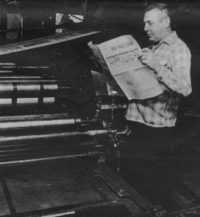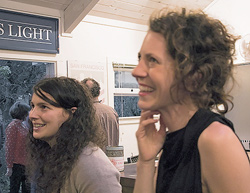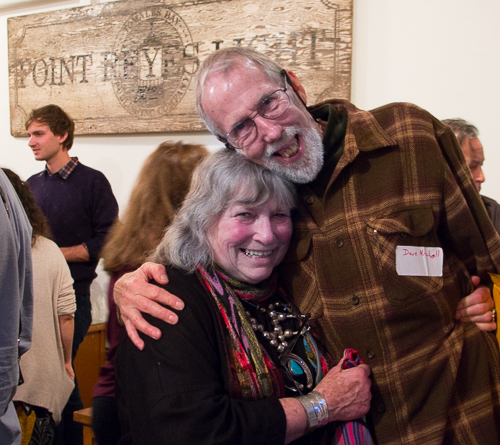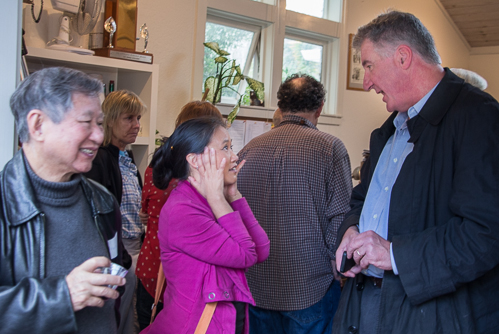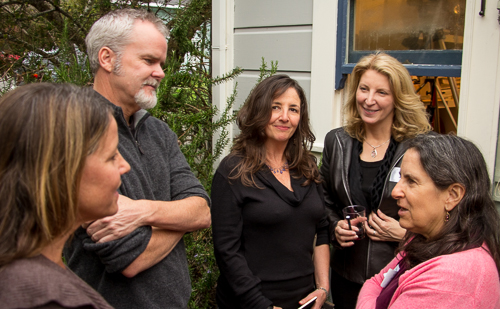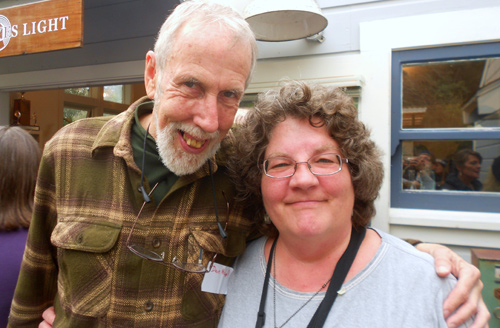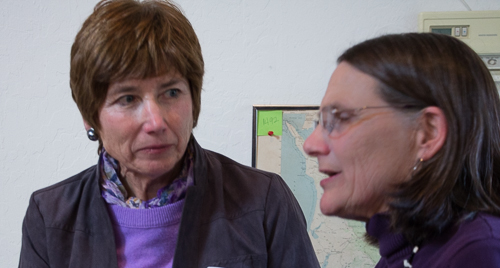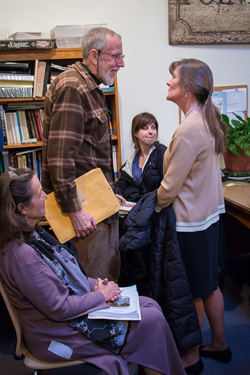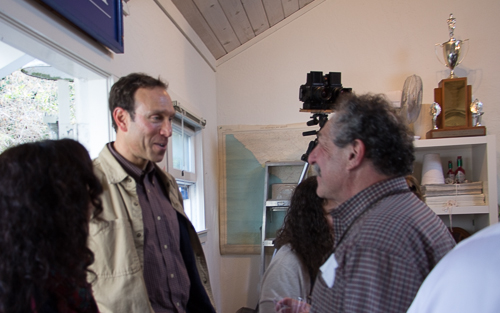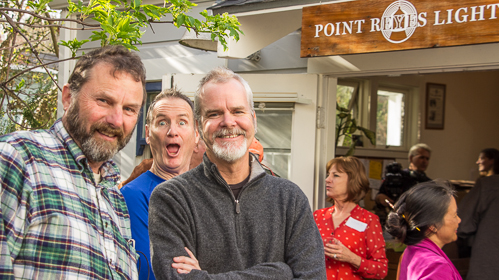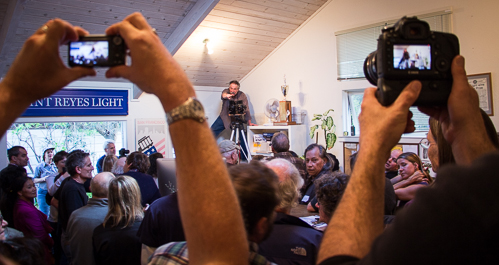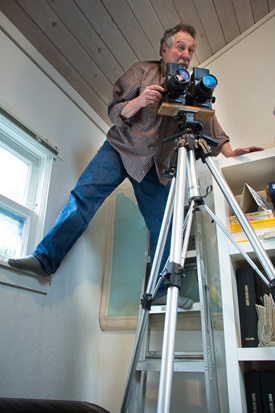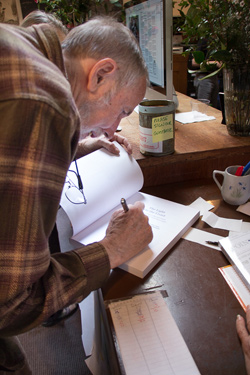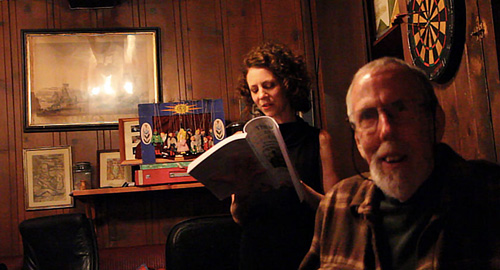Entries tagged with “Baywood Press”.
Did you find what you wanted?
Fri 15 May 2020
Posted by DavidMitchell under History, Point Reyes Station, The Point Reyes Light Newspaper
Comments Off on We’re going to miss the Station House Café
News that the Station House Café in Point Reyes Station will close at the end of this month has shocked many of us in West Marin and has generated newspaper and TV attention throughout the San Francisco Bay Area. Owner Sheryl Cahill says the new owner of the restaurant building wants to up the rent to approximately $700 per day, which she can’t afford. She hopes she can eventually reopen somewhere else.
For years while I edited and published The Point Reyes Light, I ate breakfast there almost daily and often used my mealtime to also pick up news tips, so I’m particularly chagrined by the upcoming closure. In fact, the newspaper and the restaurant have been associated in various ways for more than 50 years, beginning when the paper was published by Don DeWolfe and called The Baywood Press. Back then, the restaurant, which was located where Osteria Stellina is today, was operated by historian Jack Mason of Inverness, a retired Oakland Tribune editor.
Mason, who bought the restaurant in 1966, also wrote Funny Old World for DeWolfe’s paper, and years later in the same column, he described what the restaurant and DeWolfe were like back then. The column was reprinted in our 2013 book, The Light on the Coast. In case you missed it, here it is again:
By Jack Mason
“I’ve got an idea,” Don DeWolfe said.
I laid his medium-rare hamburger on the counter in front of him. “If so, it’s the first time,” I said, in the kidding tone one uses with an old friend, even if he is the local editor.
He didn’t bother to parry the thrust, but handed me a mustard container he had been fiddling with. “This one’s empty,” he said.
I gave him another from under the counter.
“What’s your idea?” I said. My interest was only lukewarm. Certainly I was not flattered that he would ask me for my opinion. Editors do that, ask everybody in the place what they think, then do their own thing regardless. It’s the way Great Battles have been fought and lost since the dawn of time.
He squeezed some of the brown stuff onto his hamburger patty, then pressed down hard on the bun as if afraid the meat might get away. Those were quarter-pound hamburgers I served at the Station House in 1966, and the buns all had sesame seeds on top.
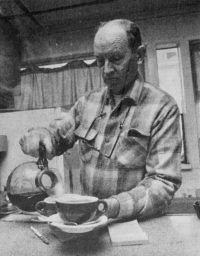
Jack Mason as owner of the Station House Café in 1967.
“The coffee will be ready in a minute,” I said. “We had a couple of customers in here awhile back, and they drank it like it was going out of style.”
“You mean you have other customers?” Don exclaimed. He dug into his burger, reaching for a napkin. “This napkin holder is empty,” he said.
I pushed one towards him from further down the counter, just as the phone rang. “Probably Willi Reinhardt,” I said. “The toilets are plugged up. That ought to take care of your crack about other customers!”
But it was Bob Vilas at the bank. “Jack,” he said, “these checks you wrote Farmer Brothers and Schwartz’s Meat Company last week. What do you expect me to do with them?”
In red-faced confusion, I told Bob it was good of him to call, and said I would be right over to take care of it, as soon as I got rid of my customer.
“You have a customer?”
“Yeah, Don DeWolfe.”

Standing beside his printing press, DeWolfe in 1967 looks over his recently renamed newspaper. Back then the newspaper was produced in the building where Rob Janes Tax Service, Coastal Marin Real Estate, and Epicenter clothing boutique are today.
“Well, tell Don for me, will you, that I think his new idea is great!”
I was really taken aback. “You mean he’s tried the idea out on you? What is it?”
“You don’t know?” Bob cried. “I thought everybody on the street was in on it.”
I hung up, stung, and stood there for a moment letting my anger cool. Here I’d been writing a column for DeWolfe, free. Writing editorials in my spare time, absolutely free of charge! And I’m the last one on the street to know about this great, world-shaking idea of his!
“What is it? I mean, your idea?” I demanded.
He was wiping his hands on four paper napkins at once. Finally he rolled them up into one big ball and dropped them in the green hamburger basket.
“Oh,” he said. “The idea.”
“Yeah, you’ve told everybody else. How about telling old Jack?”
He worked his way off the stool, and pulled some small change out of his pocket, and I mean small. “How much is a hamburger?”
“Did you have cheese on it?”
“No, I can’t eat cheese.”
“Fifty cents. And don’t bother to leave a tip.” I dropped his five dimes and three pennies in the cash drawer. The spring was broken, so we always left the drawer open.
“My idea,” he said, “is to change the name of the paper.”
I felt let down. “What’s wrong with The Baywood Press. It’s been called that for 16 years. It has tradition behind it. People are used to it. Why change it?”
“I thought Point Reyes Light would tie in better with the area,” he said. He inspected me momentarily for my reaction. “I’ll think it over,” I said.
He had to bring all his weight to bear against the door before he could let himself out; the pneumatic catch was stuck. Then he stood there a moment screwing his mouth into an odd shape.
“This is the only hamburger joint I was ever in,” he said, “that didn’t have toothpicks by the cash register.”
The name Baywood Press was changed to Point Reyes Light with the issue of September 8, 1966.
March 2, 1978
The next posting on SparselySageAndTimely.com will reminisce about the restaurant in more recent times.
Tue 4 Mar 2014
During an open house and reunion Saturday, a happy throng of Point Reyes Light readers, staff, and columnists joined with former staff and correspondents to celebrate the 66th anniversary of the newspaper’s first issue. 
The reunion drew staff and contributors who had worked at the paper at different times during the past 44 years. A number of former staff traveled hundreds of miles to attend. A couple of them arrived from out of state.
From left: Laura Lee Miller, David Rolland (who drove up from San Diego), Cat Cowles, Wendi Kallins, Janine Warner (who drove up from Los Angeles), Elisabeth Ptak (back to camera), Gayanne Enquist, Art Rogers (talking with Elisabeth), Keith Ervin (who drove down from Seattle), B.G. Buttemiller, and (in blue shirt with back to camera) Victor Reyes. (Photo by Dave LaFontaine) ______________________________________________________________
 The party was also a celebration of the Tomales Regional History Center’s publishing The Light on the Coast: 65 Years of News Big and Small as Reported in The Point Reyes Light.
The party was also a celebration of the Tomales Regional History Center’s publishing The Light on the Coast: 65 Years of News Big and Small as Reported in The Point Reyes Light.
Stuart Chapman of Bolinas, a former member of the staff, shot this photo, which he titled “Dave, Proud Father” because I authored the book.
My co-author was Jacoba Charles. Jacoba reported for The Light under its previous ownership and is a member of the paper’s board of directors under its present ownership, Marin Media Institute.
The colored Post-its, by the way, mark selections that I, along with others, would be reading to attendees. ____________________________________________________________

From left: Co-author Jacoba Charles, photographer Art Rogers, scientist Corey Goodman, photographer David Briggs, editorial consultant on the book and former member of The Light’s ad department Lynn Axelrod, and Spanish-language columnist Victor Reyes. (Except where noted otherwise, the photos in this posting were shot by former Light reporter Janine Warner)

Michael Gahagan (left), who drove down from the Sierra Nevada town of Columbia to attend, published The Light from 1970 to 1975. Here he reminisces with historian Dewey Livingston of Inverness. Dewey for many years provided a weekly historical feature titled “West Marin’s Past.”

During the Gahagan years, Lee Sims (left) was the newspaper’s main typographer. This was back in the days before offset printing, and each page that went on the press had to be composed in lead.
In a piece written for The Light’s 30th anniversary in 1978 and reprinted in The Light on the Coast, Michael Gahagan’s former wife Annabelle comments, “Poor Lee, he had the disadvantage of being a friend of ours. One can always depend on friends, and we did lean on him! He was always underpaid and overworked. (Weren’t we all?)”

Catching up on old times are (in foreground from left): former news editor David Rolland, who drove to the reunion from San Diego, former typesetter Cat Cowles of Inverness, and former reporter Joel Reese, who flew in from Chicago. Standing behind them are current reporter Christopher Peak (left) and Matt Gallagher, who filled in as managing editor from February through July 2011. _____________________________________________________________
 Samantha Kimmey (on the left) has been a reporter at The Light for the past year. With her is Tess Elliott of Inverness, who has been The Light’s editor for the past eight year. ____________________________________________________________
Samantha Kimmey (on the left) has been a reporter at The Light for the past year. With her is Tess Elliott of Inverness, who has been The Light’s editor for the past eight year. ____________________________________________________________

Gayanne Enquist was office manager during much of the 27 years I owned The Light. She was there when I arrived in July 1975, and she was there when I left in November 2005. (I was away reporting for the old San Francisco Examiner between September 1981 and the end of 1983.)

Former reporter Michelle Ling trades stories with Don Schinske, who was business manager during the 1990s and was co-publisher from 1995 to 1998. At left is her father, Dr. Walter Ling who teaches at UCLA. With his wife, May, Dr. Ling drove to Point Reyes Station for the celebration. In the background, Mary Papale listens intently to Laura Rogers.

Ingrid Noyes of Marshall (left) tells a story to my co-author, Jacoba Charles, outside The Light office.

Former staff recall the days of yore. From left: artist Laura Lee Miller, news editor David Rolland, typesetter Cat Cowles, reporter Janine Warner, and San Geronimo Valley correspondent Wendi Kallins. (Photo by Dave LaFontaine)

Sarah Rohrs was a reporter at The Light in the late 1980s. When several of us took turns reading aloud selections from The Light on the Coast, I read Sarah’s wonderfully droll account of a county fireman in Hicks Valley having to get a cow down out of a tree. (Photo by Joe Gramer)

Larken Bradley (left), who formerly wrote obituaries for The Light, chats with librarian Kerry Livingston, wife of Dewey.

Photographer Janine Dunn née Collins in 1995 traveled with news editor David Rolland to Switzerland’s Italian-speaking Canton of Ticino and to war-torn Croatia in doing research for The Light’s series on the five waves of historic immigration to West Marin. Here she chats with the paper’s current photographer David Briggs (center) and her husband John Dunn.

Former Light graphic artist Kathleen O’Neill (left) discusses newspapering in West Marin with present business manager Diana Cameron. _____________________________________________________________
 Former Light reporter Marian Schinske (right) and I wax nostalgic while photographic contributor Ilka Hartmann (left), looks on and Heather Mack (center), a graduate student in Journalism at UC Berkeley, takes notes. ____________________________________________________________
Former Light reporter Marian Schinske (right) and I wax nostalgic while photographic contributor Ilka Hartmann (left), looks on and Heather Mack (center), a graduate student in Journalism at UC Berkeley, takes notes. ____________________________________________________________

Former news editor Jim Kravets (left) jokes with photographer Art Rogers.

John Hulls of Point Reyes Station and Cynthia Clark of Novato have in the past worked with The Light in various capacities. In 1984, Cynthia set up the first computer system for the newsroom and ad department.

From left: Stuart Chapman of Bolinas, who formerly worked in The Light’s ad department, swaps stories with journalist Dave LaFontaine of Los Angeles and Light columnist Victor Reyes.

Historian Dewey Livingston (left), a former production manager at The Light, poses with former news editor David Rolland while former business manager Bert Crews of Tomales mugs in the background.

In preparing to shoot one of his signature group portraits, Art Rogers directs members of the crowd where to stand. With the throng crowded into the newspaper office, getting everyone in the right place to be seen was such a complicated operation that some of the photographer’s subjects began photographing him. _____________________________________________________________
 In shooting a series of three-dimensional photos, Art had to use a tall tripod and balance precariously on a window ledge and ladder. _____________________________________________________________
In shooting a series of three-dimensional photos, Art had to use a tall tripod and balance precariously on a window ledge and ladder. _____________________________________________________________

Art’s wife, Laura, who didn’t have to work nearly as hard, pages through a copy of The Light on the Coast. _______________________________________________________________
 The party was in part a book-signing, and I signed copies off and on all afternoon. ______________________________________________________
The party was in part a book-signing, and I signed copies off and on all afternoon. ______________________________________________________

Light editor Tess Elliott reads Wilma Van Peer’s 1998 account of working for the paper’s founders, Dave and Wilma Rogers half a century earlier. The newspaper was called The Baywood Press when it began publishing in 1948. The paper’s fourth publisher, Don DeWolfe, changed the name to Point Reyes Light in 1966.
Originally the readings were scheduled to be held in the newspaper office, but so much socializing was going on they had to be delayed until the party moved around the corner to Vladimir’s Czech Restaurant where the banquet room had been reserved.
Among those reading besides Tess were Dewey Livingston, David Rolland, Matt Gallagher, and I. Anyone wishing to watch me read former publisher (1957 to 1970) Don DeWolfe’s account of his initiation to running the paper can click here.
It was a grand party, and I want to thank present Light staff, who made arrangements for the party, and former staff, some of whom traveled significant distances to attend the reunion.
Two other book readings are also scheduled. At 3 p.m. Sunday, March 9, in Point Reyes Presbyterian Church, Point Reyes Books will sponsor readings from The Light on the Coast and from Point Reyes Sheriff’s Calls, Susanna Solomon’s book of short stories inspired by Sheriff’s Calls in The Light.
At 4 p.m. Sunday, April 27, in its Corte Madera store, Book Passage will sponsor readings from The Light on the Coast. Refreshments will be served.
Tags: Art Rogers, B.G. Buttemiller, Baywood Press, Bert Crews, Cat Cowles, Christopher Peak, Corey Goodman, Cynthia Clark, Dave LaFontaine, Dave Rogers, David Briggs, David Rolland, Dewey Livingston, Diana Cameron, Don DeWolfe, Don Schinske, Elisabeth Ptak, Gayanne Enquist, Heather Merk, Ilka Hartmann, Jacoba Charles, Janine Dunn née Collins, Janine Warner, Jim Kravetz, John Dunn, John Hulls, Kathleen O'Neill, Keith Ervin, Kerry Livingston, Larken Bradley, Laura Lee Miller, Laura Rogers, Lee Sims, Marian Schinske, Matt Gallagher, Michael Gahagan, Point Reyes Light, Sarah Rohrs, Stuart Chapman, Tess Elliott, The Light on the Coast, VÃctor Reyes, Wendi Kallins
Mon 17 Feb 2014
Posted by DavidMitchell under History, Inverness, Point Reyes Station
Comments Off on ‘Picturing the Point Reyes Peninsula’ exhibition opens in Jack Mason Museum
Inverness’ Jack Mason Museum of West Marin History held a well-attended opening reception Sunday for Picturing the Point Reyes Peninsula, “an exhibit of historical photographs of people, places, and events in Olema, Point Reyes Station and Inverness from 1869 to 1960.”
The exhibit provides fascinating glimpses into life at the foot of Tomales Bay and on Point Reyes a century ago. The photos are mostly from the museum’s own collection although a few are from the archives of the Park Service and other institutions.
The images on display were originally assembled by Carola DeRooy for a 2008 book titled Point Reyes Peninsula.
 The book’s coauthor was Dewey Livingston, historian for the Jack Mason Museum. His role was to provide the book’s text, he told me during the reception.
The book’s coauthor was Dewey Livingston, historian for the Jack Mason Museum. His role was to provide the book’s text, he told me during the reception.
Captions for photos in the exhibition were mostly taken directly from the book.
As it happens, I have long been curious about a mysterious line of rocks on Pierce Point (aka Toms Point), so I was pleased to see it getting attention in the exhibition.
“Today, hikers encounter this 820-foot-long row of granite stones (at right) about 1.5 miles along the Tomales Point Trail,” notes the photo’s caption.
“The boulders are aligned to Mount St. Helena in the east and run to the cliff edge, pointing toward the Farallon Islands in the west.
“They are named the Spirit Jumping-Off Rocks by the Coast Miwok tribe who believe when a person dies, their spirit walks west.
“The rock line is man-made and appears on an 1862 Coast Survey map. However, who built the wall, for what purpose and when, still remains uncertain.” ________________________________________________________________________
 Mexican Land Grantee. “In 1836,” according to the caption, “Rafael Garcia (right) received Rancho Tomales y Baulenes, some 9,468 acres from the slopes of Tamalpais to Tomales Bay, as a reward for halting Native American rebellions at the mission [San Rafael Arcángel].
Mexican Land Grantee. “In 1836,” according to the caption, “Rafael Garcia (right) received Rancho Tomales y Baulenes, some 9,468 acres from the slopes of Tamalpais to Tomales Bay, as a reward for halting Native American rebellions at the mission [San Rafael Arcángel].
“The first Mexican land grantee on Point Reyes, Garcia moved to Olema, where he built a well-appointed adobe house for his large family.
“This sketch of the widely know patriarch Don Rafael was drawn by a Russian naturalist, I.G. Voznesenskii, on a visit to the rancho in 1845.” (Marin History Museum photo)
Olema was in its heyday during the 1860s and 1870s. Back then it had two hotels, a general store, six bars, bi-weekly stagecoach service to San Rafael, and weekly steamer service to San Francisco via Tomales Bay. __________________________________________________________________________

“Olema’s fine schoolhouse, with meeting hall upstairs, was named Garcia School after the original resident of the area. The schoolhouse, located on the lane to the Shafter Ranch, burned and was replaced in a different location in 1915.”

“The arrival of the North Pacific Coast Railroad in 1875 signaled the end of Olema’s growth and heyday. The narrow-gauge rail line originated in Sausalito (where ferries connected to San Francisco) and headed north via San Anselmo, San Geronimo Valley, and Tomales Bay,” the photo’s caption explained.
“The destination was the rich redwood timber of the Russian River area. Bypassing Olema through a trick of geography, the tracks met at the head of Tomales Bay at a wide, flat pasture two miles from town.”
Point Reyes Station had not existed before the railroad erected a depot in the pasture, but the town that quickly sprung up around the depot soon overshadowed Olema commercially. (Seen above) a train crosses an S-shaped trestle over Papermill Creek as it enters Point Reyes Station from the east.

“Train passengers could be met by a stage at Point Reyes Station and transported to the numerous attractions of the area. Here a group of women and their male companion have chosen bicycles as their mode of exploring Point Reyes.”

“Real estate agents attracted potential buyers to Inverness beginning in 1889 with camping trips and promises of a grand hotel.
“City people enjoyed setting up their tents on potential building lots, and a few actually bought; but Inverness was slow to take off. By the 1920s, it had established its reputation as a cozy summer resort, scattered with quaint cabins but sans first-class hotel.
 However, “not all Inverness families were summer residents from the cities.
However, “not all Inverness families were summer residents from the cities.
“True locals included those who provided services, [such as] carpenters, plumbers, stonemasons, shopkeepers, and the Hom family, operators of the local laundry.
“The Homs raised a large family in Inverness, and many of the kids ended up going to a university or into successful trades.”
One of the Hom girls changed her name to Tong and became a “fan dancer” in San Francisco, Meg Linden from the museum told me Sunday. _________________________________________________________________________
 Shipwreck. “Heavy fogs, dangerous surf, and the jutting and rocky Point Reyes headland itself posed hazards for the coastal sea captain during the 19th century.
Shipwreck. “Heavy fogs, dangerous surf, and the jutting and rocky Point Reyes headland itself posed hazards for the coastal sea captain during the 19th century.
“Dozens of ships went aground at Point Reyes, often in a dramatic fashion, while few lives were lost.
“The coastal steamer Samoa went aground at Ten Mile Beach in 1913, prompting a dramatic rescue by men at the nearby Life-Saving Station.
“The wreck drew curious visitors for many days until the ship broke up; the bow of the ship made an interesting landmark for many years before disappearing into the sand.” _________________________________________________________________________

“The US Coast Guard superseded the Life-Saving Service in 1915, and in 1927, an entirely new Point Reyes Lifeboat Station was built at a sheltered spot in Drakes Bay. The handsome boathouse-and-barracks building was constructed on pilings and features a marine railway from which heavier, motor-driven lifeboats could be launched.” (Point Reyes National Seashore Archives photo)

“This aerial view shows the entire Point Reyes Lifeboat Station, now a National Historic Landmark, and the neighboring commercial fish docks. At the bottom is the boathouse and in the trees near the center are the officer-in-charge’s house and auxiliary buildings.
“A radio tower, surrounded by a circular fence, is at the far left, and the barge in the foreground is the Navy paint-test barge, on which marine paints were tested.” _________________________________________________________________________
 Point Reyes Lighthouse. “The handsome yet functional light tower was constructed of iron plats bolted and riveted together, all secured into the solid rock-and-concrete foundation 273 feet above the crashing surf.
Point Reyes Lighthouse. “The handsome yet functional light tower was constructed of iron plats bolted and riveted together, all secured into the solid rock-and-concrete foundation 273 feet above the crashing surf.
“Inside the delicate-looking lantern room, an intricately assembled Fresnel lens was mounted on a meticulously balanced circular track.
“The entire First-Order lens and lamp assembly turned at a carefully geared pace to produce a flash every five seconds.
“Famed pioneer photographer Eadweard Muybridge took this photo of the newly constructed lighthouse in 1870 or 1871.”

Before the advent of refrigerated cargo, fresh milk from Point Reyes could spoil if it were shipped to San Francisco. Instead, the cream was skimmed off and churned into butter, which could be shipped without refrigeration.
“‘Modern technology‘ of the late 1880s brought the DeLaval separator, which skimmed cream instantly. Ranchers fed the skim milk to pigs, which provided a supplemental income.
“This photograph shows the Claussen dairy at E Ranch [on Point Reyes], where Henry Claussen (right) and his butter maker John Paulino show off the separator [and] the steam engine. The large churn is out of the picture on the right.”

“Point Reyes Station’s first school was built in 1879 on the hill above town. Named after the pioneer owner of the property on which the town school stood, the Black School District’s classroom soon overflowed as the town grew. This class included the children of dairy ranchers, rail workers, and merchants.”

“A fine new school, also called Black School, was built in 1905 on a flat lot in town. The impressive architecture illustrated the town’s prospects at the time.
“The 1906 earthquake damaged the schoolhouse but not until the 1950s was the venerable institution replaced by the modern West Marin Elementary School, located opposite the pioneer schoolhouse up the hill.”
This building, which no longer exists, was located on the site of the today’s firehouse. _____________________________________________________________________
 “Bear Valley ranch owner Gene Compton, owner of a San Francisco cafeteria chain, opened his central pasture to the public for a fully accredited western-style rodeo in 1946-1948.
“Bear Valley ranch owner Gene Compton, owner of a San Francisco cafeteria chain, opened his central pasture to the public for a fully accredited western-style rodeo in 1946-1948.
“Local cowboys joined professional circuit riders to the benefit of local charities.
“The new local newspaper, Baywood Press, covered the event,” the photo caption notes.
The Baywood Press, which was founded on March 1, 1948, changed its name to Point Reyes Light in 1966.
The photos here are only a sampling of what the exhibition contains, and the exhibit itself is basically a sampling of the many historic photos in Point Reyes Peninsula. The 128-page book is available from Arcadia Publishing for $21.99.
Tags: Baywood Press, Bear Valley ranch, Black School District, Carola DeRooy, Dewey Livingston, E Ranch, Garcia School, Gene Compton, Henry Claussen, John Paulino, Point Reyes Lifeboat Station, Point Reyes Lighthouse, Rafael Garcia, Tomales y Baulenes land grant, wreck of the steamer Samoa

